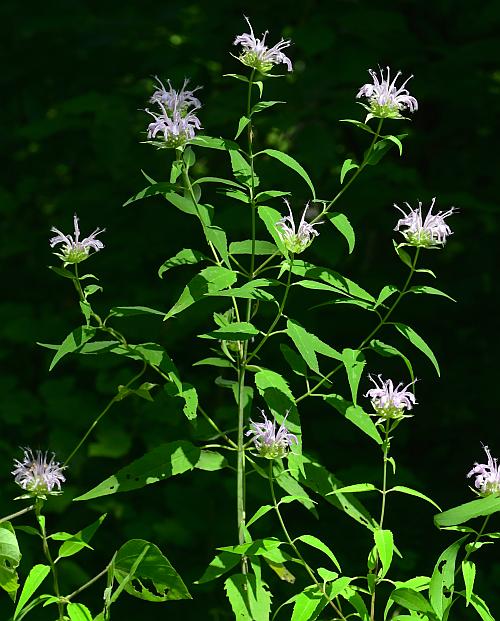Monarda fistulosa L.
Wild Bergamot

Native
CC = 4
CW = 3
MOC = 89
© SRTurner
Monarda fistulosa L.Wild Bergamot | |
 |
Native CC = 4 CW = 3 MOC = 89 |
© SRTurner |
|
Family - Lamiaceae Habit - Perennial forb from fibrous roots or slender rhizomes, usually strongly colonial. Stems - Ascending to erect, to 1.2 m, unbranched or branched, 4-angled, glabrous toward the base, sparsely to moderately pubescent toward the tip with fine, downward-curled hairs, sometimes also with scattered, longer, spreading hairs, the more glabrous variants often somewhat glaucous.
Leaves - Opposite, decussate, petiolate, the median leaves more or less the largest. Petioles 2-25 mm long (those of all but the uppermost leaves 10-25 mm), puberulent, with adaxial groove. Blades 2-10 cm long, ovate to broadly ovate or ovate-triangular, those of the uppermost leaves often lanceolate, broadly angled to rounded, broadly rounded, or nearly truncate at the base, angled or tapered to a sharply pointed tip, the margins with widely to relatively closely spaced, usually fine teeth, also hairy, the upper surface glabrous or sparsely pubescent with short, fine, loosely appressed hairs, the undersurface glabrous or pubescent with short, fine, loosely appressed hairs and/or longer, spreading to somewhat curved hairs, especially along the veins, both surfaces with sessile glands. Herbage fragrant.
Inflorescence - Terminal, usually solitary flower cluster, the subtending bracts 10-25 mm long, lanceolate to ovate, the margins entire but hairy, the surfaces glabrous or the undersurface sparsely to moderately pubescent with short, curved hairs, green, but often pale or pinkish-to purplish-tinged. Innermost bracts 6-10 mm long, mostly linear, the margins hairy. Flowers on tomentoulose pedicels to 1mm long.
Flowers - Calyces 7-10 mm long, 13-ribbed, the outer surface moderately pubescent with minute hairs, some or all of these gland-tipped, densely bristly-hairy in the throat, the lobes 1-2 mm long, long-tapered above a very short, triangular base, but lacking a bristlelike extension. Corollas bilabiate, 20-35 mm long, pink to light purple, lacking spots or mottling on the lower lip, densely pubescent with minute, curled, nonglandular hairs on the outer surface, the lips, especially the upper lip, with dense, longer, spreading hairs toward the tips, also usually with inconspicuous sessile glands, glabrous in the throat, the lips somewhat shorter than the tube, the upper lip straight or nearly so, the lower lip more or less entire, with a slender, flangelike, usually 2-toothed extension at the tip. Stamens 2, conspicuously exserted from the corolla. Filaments to 1.4 cm long, white, glabrous. Anthers 2 mm broad, with brown-purple margin. Style to 3 cm long, white below, pinkish-purple at apex, pubescent. Stigma unequally two lobed.
Fruits - Nutlets 1.5-2.0 mm long, brown to black.
Flowering - May - August. Habitat - Upland prairies, upland forest openings, savannas, glade margins, streambanks, fields, fencerows, railroads, and roadsides. Also cultivated. Origin - Native to the U.S. Lookalikes - None. Other info. - This attractive and fragrant species can be found throughout Missouri and most of the eastern half of the continental U.S. It is easily identified by its tall and colonial habit, opposite triangular leaves with pronounced teeth, and distinctive flowering heads. The plant is fragrant with a scent reminiscent of oregano. M. fistulosa is often cultivated for its showy flower heads and pleasant fragrance. The flowers attract butterflies and hummingbirds, and the leaves are sometimes used to prepare tea. The flowers can be used to dress up a salad or garnish a meal. The plant is easily propagated from seed and grows well in a garden. It is tolerant of poor soils and some drought. Photographs taken at Logan Creek, Reynolds County, MO., 7-17-03 (DETenaglia); also at Klondike County Park, St. Charles County, MO, 7-12-2010, Weldon Spring Conservation Area, St. Charles County, MO, 7-3-2013, Little Lost Creek Conservation Area, Warren County, MO, 7-7-2020, and Shaw Nature Reserve, Franklin County, MO, 7-21-2020 (SRTurner). |